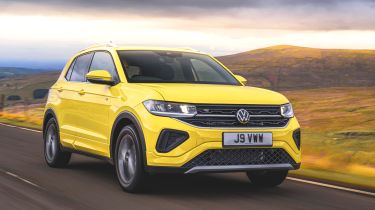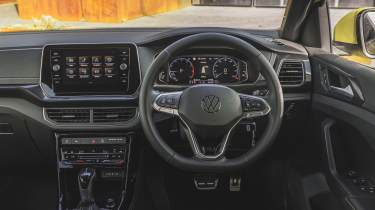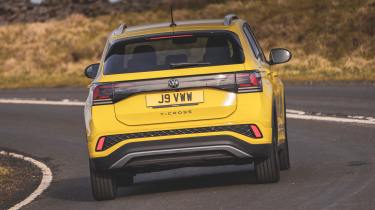New Volkswagen T-Cross 2024 review: a small SUV that struggles to stand out
VW’s smallest SUV leads on value and image, but is too unremarkable to stand out in its crowded segment?

Verdict
There’s little to dislike about the Volkswagen T-Cross, and it comes with certain appeal thanks to its upmarket badge and playful colour options. But this compact SUV exists in a very crowded class, and there’s no real reason to buy one of these over an equivalent SEAT Arona or Skoda Kamiq. Look outside of the VW stable and something like the hybrid-powered Toyota Yaris Cross might be a better option.
The Volkswagen T-Cross has been a hugely popular model for the German brand since it launched a few years ago, often occupying the upper-end of the sales charts in both the compact SUV segment, as well as overall. Yet so fast-moving is this B-segment SUV class that VW cannot rest on its laurels, making this mid-life update critical to maintain market share.
As before, the T-Cross uses the same platform as the Polo supermini, as well as a swathe of VWGroup SUVs of a similar size – such as the Skoda Kamiq and SEAT Arona. All are based on the simplified MQB-A0 architecture, limiting all models to a relatively rudimentary torsion beam rear-suspension design.
What this platform does allow for is excellent space efficiency and flexibility, something seen in the T-Cross’s 455-litre boot. That allows the car to sit among the more practical cars in this segment, despite having one of the smallest footprints. This comes at the expense of rear-seat space, which can be tight, but the second row is adjustable, allowing customers to prioritise space where it suits them best.
Used - available now

2022 Volkswagen
T-Cross
42,106 milesManualPetrol1.0L
Cash £13,406
2022 Volkswagen
T-Cross
16,861 milesManualPetrol1.0L
Cash £15,500
2022 Volkswagen
T-Cross
49,490 milesManualPetrol1.0L
Cash £12,231
2021 Volkswagen
T-Cross
55,793 milesManualPetrol1.0L
Cash £12,400VW has kept the changes light. There’s some new design elements inside and out, plus a fetching range of new colours including a (bravely) crowd-sourced name called ‘Rubber Ducky Yellow’. Both the front and rear bumpers have also been given a light update, but it would take some fairly sharp eyes to pick out the differences on the road. The rear lights now feature a more arresting X-wing design that’ll definitely turn some heads on higher-trim models.
The cabin has picked up a more substantial update, with a new dashboard design, plus brighter fabrics and materials. As before, this is a solid and well-built interior, but we wouldn’t go looking for particularly plush materials.
The cabin might not be as visually interesting as the one found in a Peugeot 2008 or Renault Captur, but visibility is good thanks to a relatively upright windscreen and a high driving position.
The tech on offer is average at best, with a base eight-inch or optional 9.2-inch touchscreen display that uses an older generation of software to what we’re used to in the latest Golf or Tiguan. A notable inclusion, though, is the standard eight-inch or optional 10.25-inch driver’s display available on R-Line models and above. Android Auto and Apple CarPlay are standard fit, and in the case of the latter can connect wirelessly.
T-Cross models feature either a three-cylinder 1.0-litre engine available with manual or dual-clutch transmissions, or a 1.5-litre four-cylinder option with a sole automatic. Despite the SUV styling, there’s no all-wheel drive version, but this is not unusual in the class.
We’re driving the 113bhp 1.0-litre three-cylinder model connected to the dual-clutch transmission. While it’s not a quick car, it is capable thanks to a reasonable amount of low-down torque. The transmission can be a little laborious if you’re indecisive with the throttle, but this is a trademark of the transmission type and not specific to the T-Cross.
This engine and gearbox combination is quite efficient, though, and as we found it was easily capable of 50mpg on a gentle run. It’s also a pretty refined combination, remaining hushed even when being worked to its maximum.
On the road, the T-Cross drives with a crisp and clean quality. Ride comfort is good, without feeling too soft or too firm. To help things along, it has accurate steering and good response from the controls, making it about as easy to drive as new cars get. This type of car will never elicit a grin when flowing down a country road, but there’s nothing inherently wrong with the driving experience.
The thing is, though, there’s just no wow factor beyond the bright paintwork and retro rear lights. Within the extended VW family, the Kamiq and Arona are more interesting to look at and to sit in, and offer near-identical driving experiences – all at a lower price.
A Toyota Yaris Cross is even easier to drive, and more efficient on account of its hybrid powertrain, while Ford’s Puma is the sharper driver’s car if that’s what is important to you. The Renault and Peugeot are plusher and more stylish, and there’s the incoming Dacia Duster, which is bigger and much cooler to look at. It’ll probably be cheaper, too.
| Model: | Volkswagen T-Cross R-Line 1.0 TSI DSG |
| Price from: | £29,070 |
| Price as tested: | £30,570 |
| Engine: | 1.0-litre 3cyl turbo petrol |
| Power/torque: | 113bhp/200Nm |
| Transmission: | Seven-speed automatic, front-wheel drive |
| 0-62mph: | 10.3 seconds |
| Top speed: | 119mph |
| Economy/CO2: | 49.0mpg/131g/km |
| L/W/H: | 4,127/1,760/1,573 |
| On sale: | Now |










